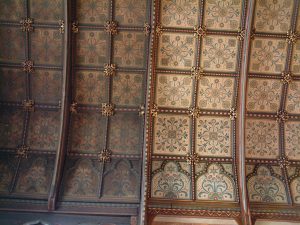Celebrating 35 Years of Hirst Conservation
December 17, 2021 | By Hirst-Conservation |
This year we celebrate our 35th anniversary. We thought we would mark this significant milestone by looking back over the how the business has changed since it was started by Elizabeth Hirst in 1986.
Liz founded the business after training and working with Professor Robert and Mrs Eve Baker. Whilst exposed to all aspects of historic building and fine art conservation, Robert tended to focus more on stonework whereas Eve had a love for medieval wall paintings. The early years of Liz’ career not only included a variety of site visits but also opportunities to stop at antiquarian book shops. A hobby that promoted a love of books. Something that is evident in the diversity of the library that has grown at the Hirst’s’ Lincolnshire offices over the years.
Our offices were initially based in a portacabin in the garden of the Lincolnshire farmhouse, but has now grown to extensive complex of offices, laboratories and workshops. The number of projects that have taken place since 1986 are too many to recall, but during the course of our work we have built up an extensive library of books and archives, condition records, building surveys, treatment reports and photographic images of an impressive array of churches, cathedrals, stately homes and important buildings across the country and overseas.
The first project was conservation of the 14th century polychromed and gilded Caen stonework at Prior Crauden’s Chapel at Ely Cathedral. The works in the Chapel necessitated a team of half a dozen people, rather than Liz working as a solitary conservator, so Hirst Conservation was born.
Over the years there has obviously been an array of qualified conservators and specialists we have had the pleasure to work with. A lasting partnership with Paul D’Armada has been there since the beginning. He is not only an extremely talented artist and conservator but also a chemist and a physicist. Outsourcing analysis in 1986 was very difficult, so we set up our own labs that we now heavily rely on. We couldn’t possibly count how many mortar and plaster samples have been analysed in there.
35 years ago, the conservation industry was at a fledging stage, without any professional organisations such as ICON, IHBC, or regulatory bodies. The industry has developed and so too have the partnerships and the infrastructure needed that supports our work, including laboratory and analytical services, H&S and regulatory compliance.
The next big challenge for us all is to turn towards sustainability. Addressing how conservation can continue to support adaptation of buildings to encourage development rather than demolition. We continue to research materials and have undertaken numerous trials over the years. Such as assessing the behaviours of specific linseed oil paint in internal and external conditions; lasting products that are compatible with the historic structures mean less frequent maintenance and less environmental impact, so it is beneficial to have a good practical understanding of material performance.
We have had the pleasure of working on so many historic structures over the years from Ely Cathedral in the 1980s. Uppark House after the fire in 1989 when we made a pre-aged lead paint to fulfil the brief that it should look like the day before the fire, All Saints Church Cambridge in the early years when we met Paul,
Keeble College Oxford in 2003-04 and Cusworth Hall soon after, Cardiff Castle (1999 – 2004)
To some more recent projects including numerous surveys at Wentworth Woodhouse; Dover Town Hall & laser cleaning the alabaster archivolt at Tutbury.
This year also marks a 21-year anniversary for both Tim Pretty and Sabina van de Bruck who joined the Hirst team just weeks apart. Tim heads our plaster & monuments division with Sabina leading the stone & wall paintings division. Both have amassed a considerable portfolio of projects over their 21 years at Hirst. Something we hope to explore further in forthcoming feature of team recollections.
Our projects are often very diverse and draw on different disciplines including stone, terracotta, plaster, fine art, wall paintings, timber and other applied decoration, as well as mortar analysis and paint research. Our team has a wide range of experience in different disciplines, so we work together to find appropriate solutions. There are often many factors to consider prior to making any conservation decisions, so there isn’t the option of a textbook treatment. Conservators by their very nature need to be problem solvers.
Conservation of a painted surface in a church will be a very different to the approach used on a painted object in a museum. The need to understand environmental conditions, the whole building envelope and its use, all need to be considered in order to guide the approach and offer advice on how the conditions may be improved. Utilising new materials and techniques alongside traditional materials that have been unchanged for centuries, this is what makes our work so special.
Building conservation needs a wide variety of skills not just applied decoration, for example, but an understanding of construction, substrates, environmental factors. Not to mention the interaction of materials and past interventions. Buildings need to remain functional; they need to remain relevant to survive, otherwise we risk losing them.














